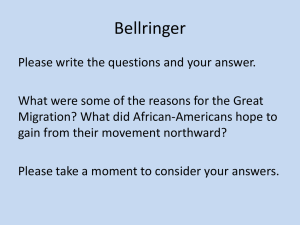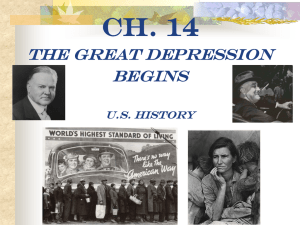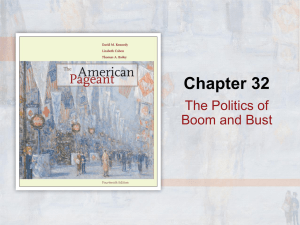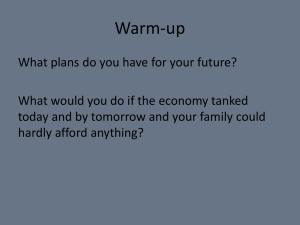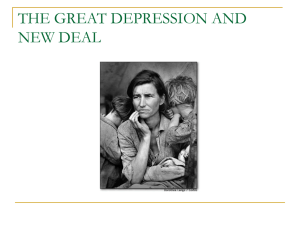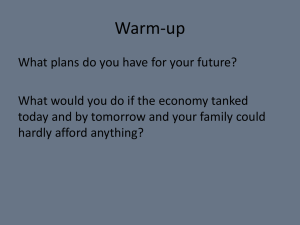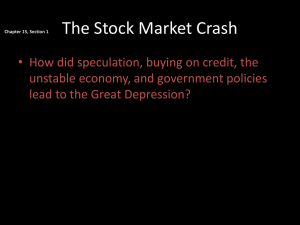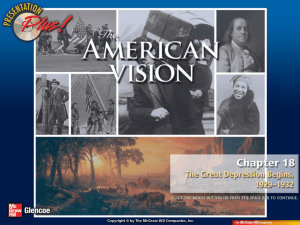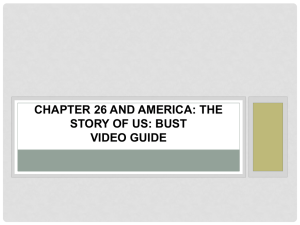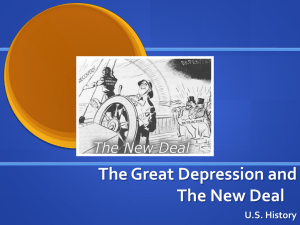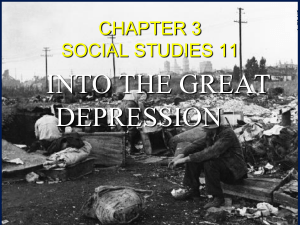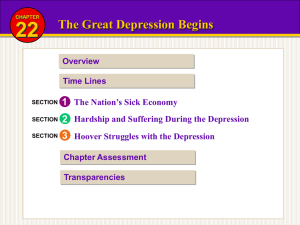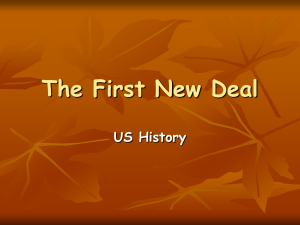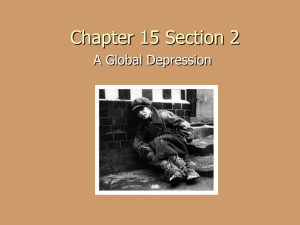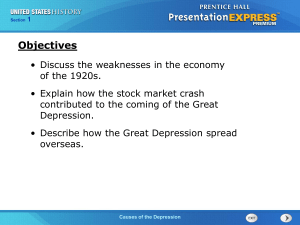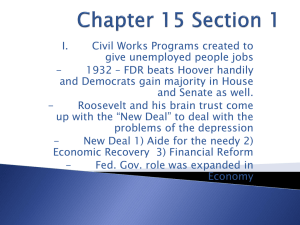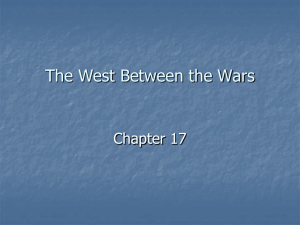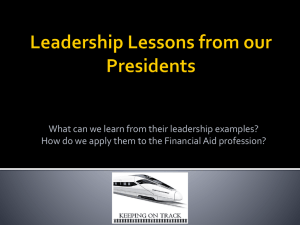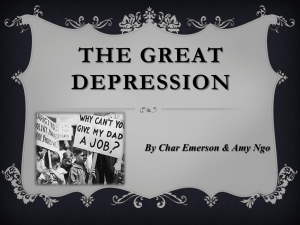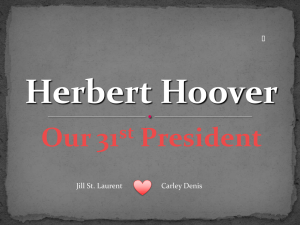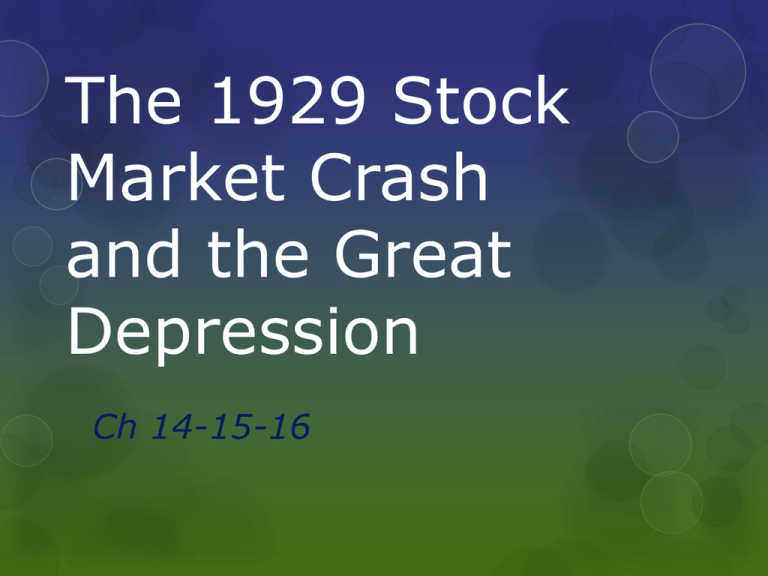
The 1929 Stock
Market Crash
and the Great
Depression
Ch 14-15-16
The Causes of the
1929 Stock Market Crash
Economy appeared healthy in the 1920’s
“Wonderful Prosperity” – normal people doing well, stock market
Welfare Capitalism – employers gave workers benefits to keep strikes away
Signs of Economic Danger
Uneven Prosperity
Personal Debt
Playing the Stock Market
Too many goods, Too Little Demands
Trouble for Farmers and Workers
Economies run in cycles
** Up cycles occur when capital and opportunity exist
** Down cycles occur when either capital or opportunity or
both are not present
The Market Crashes
Black Thursday – October 24,1929
Stocks fell slowly from September on, major fall on 10/24
Business and Banking leaders told investors not to panic
President claimed nation’s businesses were on “a sound and prosperous basis”
Black Tuesday
To stop panic, bankers pooled their money and bought stock
Too little too late – on 10/29 the market crashed ($30B losses in one day)
The Ripple Effect
Early on, only heavy investors hurt by crash/Some lost EVERYTHING
Within a short time, the effects were widespread
Soon, millions who never owned stocks were effected
Ripple Effects (downward spiral)
Risky Loans to Banks
(banks earn profits by loaning money out. In this era, banks loaned to
Consumer Borrowing
(consumers borrow from banks, stores and couldn’t pay back)
risky businesses)
Bank Runs
(Fearful of failure, people rushed to withdraw their money from banks)
Bank Failures
(banks didn’t have enough money on hand to give money to all their investors)
Savings Wiped Out
Cuts in Production
(If bank failed, savings wiped out, no safety net)
(without being able to borrow, businesses cut production of goods)
Rise in Unemployment
(business cutbacks meant people were laid off)
Further Cuts in Production
(without jobs, people stopped buying goods, causing further
cutbacks)
DOWNWARD SPIRAL – economy spiraled down and down causing an
“economic contraction” – a decline in goods and services produced. A
large contraction is called a DEPRESSION and in the 1930’s, the United
States was in a depression - THE GREAT DEPRESSION
Impact on Workers
and Farmers
Factories thru out the country cut back or shut down, laying off workers
Others had hours cut or pay cut
Henry Ford shut down factories (75,000 workers let go)
Other businesses cut back or closed as unemployed workers had no money to spend
Prices farmers got for crops so low they couldn’t break even
Formerly wealthy families laid off their servants (one of few jobs for minorities)
Gross National Product (GNP) dropped by 50%
DOWNWARD SPIRAL
Impact on the World
By 1930’s, banks, manufacturing and trade make world interdependent
Europeans depended on US for investment money and US markets
After WW1, US insisted England and France pay back money loaned
them during the war. England and France used money from Germany to
pay back these debts
When US companies quit investing in Germany, it couldn’t make
reparation payments, thus England and France couldn’t pay back US
This was another hit to US economy
DOWNWARD SPIRAL
Underlying Causes of the Depression
The Stock Market Crash DID NOT cause the Great Depression. It was
just a part of bigger economic problems
AN UNSTABLE ECONOMY –
Wealth was unevenly distributed (a few controlled too much of the money)
Those with control of the money quit spending when the market crashed
Industry quit producing goods when people quit buying things
Farmers/workers at the bottom during the good times of the 1920’s were hit hard
OVERSPECULATION
Goods and Stocks bought on credit/margin now created an unpayable debt
Stock Market was based on borrowed money and overinflated values
GOVERNMENT POLICIES
Monetary policies made things worse
Federal Reserve policy of restricting money to discourage lending
Tariffs to encourage buying US made products
Interest rates cut to spur economy kept prices down/no profit for companies
Social Effects of the Depression
Most thought Depression would not last very long, could ride it out
Those who would never have thought to ask friends, family or the
government for money found they had no other choice
POVERTY SPREADS
Most had saved some money for a “rainy day” (lost when banks failed)
Most felt secure in their jobs (lost when company cut back or closed)
But that all changed with the Great Depression
HOOVERVILLES – so many lost their jobs/homes, that homeless camps
sprung up all over the country (15,000 in NYC alone). Nicknamed these
camps “hoovervilles” after President Hoover as an insult to him
Many kept moving, looking for work. These hobos or drifters rode the
rails from town to town chasing non-existent jobs
More than 1 million hobos/drifters in 1933
Social Effects of the Depression
FARM DISTRESS – Prices went from low to lower
Unable to pay their mortgages, farmers lost their farms to the banks
Banks would sell at auctions (penny auctions)
In protest of low prices and bank practices, farmers destroyed their crops, dumped
their milk, broke their eggs
Nation was shocked at protest, when people were literally starving to death
THE DUST BOWL
Many who tried to keep farming were destroyed by the “DUST BOWL”
10 years of drought made farming impossible
Environmental catastrophy so bad that dust blew into “black blizzards”
60% of farmers lost farms. Dust Bowl migrants took off to find work
Many head out west to California’s agricultural belt. Some jobs, but not nearly
enough for those who needed work
Poverty Strains Society
Serious physical and psychological toll taken on entire country
Unemployment or fear of losing job caused great anxiety
Many depressed, many considered suicide, some did take own lives
IMPACT ON HEALTH
President Hoover stated, “No one has starved”, but some did. Thousands of
others went hungry, got sick, lost shelter
Many grew food on whatever land they could (relief gardens). Used food to
barter for things they had no money to buy. Others sold food on street
corners
Others dug through trash hoping to find some scrap of food
STRESSES ON FAMILIES
As they lost homes, many families moved in together
As they lost jobs, they gave up small extras (movie ticket, treat)
Men felt like failures because they could not provide for their families
Most ashamed, too embarrassed to ask for help. Some men left their families
to try to find work or just to escape
Women had to worry about feed their children. Working women accused of
stealing men’s jobs. Many placed fired women or refused to hire them, even
if they were the only one supporting the children
DISCRIMINATION INCREASES
Minorities, already hurting, were first fired/laid off
Faced hostilities if they had a job (stole from white men)
Black unemployment was over 56%
Government relief programs rarely benefitted people of color
Justice system ignored rights of minorities
Scottsboro Boys – 9 black youths riding the rails accused of raping 2 white women
Without chance to get an attorney, convicted and sentenced to die
After many years of fighting, convictions overturned (Legal Defense Fund)
Surviving the Great Depression
AMERICANS PULL TOGETHER
Farmers stick together
Penny Auctions – States passed laws suspending foreclosure sales (fearing violence)
Young people ride the rails
Young left home (to decrease burden) and road the rails looking for work/adventure
Hobo life often dangerous – symbols left to help direct
Seeking Political Solutions
Many saw capitalism as broken – needed a new system
Communism & Socialism attract attention but not votes
Depression Humor
Hoovervilles, hoover blankets, hoover flags
Babe Ruth criticized for taking $80,000 salary (more than president). He is quoted as
joking “I had a better year”
Signs of Change
Looking back, we now know WW2 brought the US out of the Great
Depression, but at the time, Americans looked for any sign that things
were getting better
PROHIBITION REPEALED - 21st Amendment ratified in 1933
EMPIRE STATE BUILDING built – NY Governor FDRoosevelt used this as
a symbol of better things to come. It created jobs and the city of New
York got a beautiful building that set them apart
THE END OF AN ERA – as the 1930’s drug on, it became obvious that
the Roaring 20’s era had come to an end (good and bad)
Al Capone arrested and jailed for tax evasion
Babe Ruth retired
Lindberg baby kidnapped and killed
Hoover’s Strategies
Hoover was a believer in “laissez faire” government. He believed the
economy would correct itself, if left alone
Hoover believed the US economy was sound enough to withstand the
Stock Market Crash and other economic issues
Business and Government leaders also preached the idea that the
economy would recover soon, and to be patient
VOLUNTARY ACTIONS FAIL –
Got business leaders to agree to keep wages the same at first, but to stay in
business, most would eventually lay off workers and/or cut their wages
Public began to blame Hoover for the Great Depression (GD)
His unwillingness to intervene angered those hurt by the GD
The Government Acts – finally
TOO LITTLE TOO LATE
Agricultural Marketing Act – designed to stabilize farm prices
Failed miserably – lost $150 million dollars
Republicans crushed at midterm elections
Government spending on public projects went up (jobs) Hoover Dam
Hawley Smoot Tariff – highest import tax in US history (to keep Americans
buying American made products)
Hoover suspended war loan repayments. European economies still fall
Reconstruction Finance Corporations
Government credit to large industries to keep them running
Government loans to banks to keep them open and lending money
Home Loan Act – lowering loan rates, refinancing existing loans
Hoover’s Unpopularity Grows
Hoover insisted STATE and LOCAL governments handle relief efforts
Hoover believed direct relief would damage a person’s self respect
Fairly or not, most people blamed Hoover for their problems
Private Charities opened – not nearly enough help for those in need
VETERANS MARCH ON WASHINGTON
WW1 Veterans had been promised a BONUS in 1945
20,000 jobless, homeless vets marched on Washington demanding bonus NOW
Hoover sent in troops to keep order/peace
General Douglas MacArthur decided to use force to clear out marchers
US Vets faced their own army, many injured
HOOVER and US horrified at military action
Hoover took responsibility, final “nail in his coffin”
Great Depression Test Essays
1) The Great Crash of 1929 caused as country-wide and
world-wide “ripple effect”. Explain this “RIPPLE EFFECT”.
2) Compare the 2 candidates for president in 1932.
How did their beliefs in government action as a way to
deal with the Great Depression differ? EXPLAIN
3) Identify 2 actions taken by Franklin D. Roosevelt to
try to help those impacted by the Great Depression.
Explain HOW those actions were intended to provide aid
to those in need.
Alphabet Agencies
Use your book (p. 536-544) to find 10 alphabet agencies
Give their letters
Give their worded title
Explain what they were designed to help
A NEW DEAL for America
Franklin D. Roosevelt (FDR) pledged a “New Deal” for America
Governor of New York – built image on hope (Empire State Building)
Believed it was the responsibility of those with wealth to use their efforts to
help those in need
Crushed Hoover in 1932 elections
Hoover asked voters to give him/his policies more time to work. That the
Great Depression would come to an end and the US would rise us again
FDR promised a “NEW DEAL” for America. He promised the government
would act to help those in need. The government would act to spur the
economy and bring the US out of the Great Depression
FDR CRUSHED Hoover in 1932 election (democrats gained control over both
housed of Congress)
FDR had a “MANDATE” from the voters to use the government to stop the Great
Depression and provide aid for those in need
Actions of FDR years
First 100 Days (Alphabet Agencies)
Stabilizing Financial Institutions (Bank Holiday, FDIC, SEC, off gold standard)
Provided Relief and Created Jobs (FERA, CWA, CCC)
Regulated the Economy (NIRA, NRA, PWS)
Assisted Home Owners and Farmers (AAA, FHA, HOLC)
The Tennessee Valley Authority (TVA)
2nd New Deal
New and Expanded Agencies (AAA, FSA, WPA)
Rural Electrification (REA)
New labor Legislation (Wagner Act, NLRB)
Social Security
Old Age Pensions
Unemployment Insurance
Aid for Dependent Children and the Disabled
New Deal missed some
Minorities
New Deal programs, especially in South, enforced segregation
New Deal programs (skilled jobs) were not offered to minorities
Government did little, nothing to stop discrimination
Unemployment was well over 50% for African Americans
Women
Relief programs not aimed at women, most excluded women
Jobs women could get were not provided for in New Deal programs
FDR did appoint minorities and women to key government
positions, the first president to do this
Critics of the New Deal
Then and now, many believe the government actions taken during the
Great Depression not only did not end it, but lengthened
DID TOO MUCH - many in FDR’s day argued that the government
actions went way too far. Many, especially the wealthy, saw much of
New Deal as “socialist”
2nd New Deal passed the Wealth Tax Act that raised the tax rate on those who
made more than $50,000 per year
Social Security Act took money from successful workers and gave it to those
who were not successful
DID TOO LITTLE – many FDR supporters wanted him to push even
further in redistributing the wealth of the nation
Sinclair Lewis (the Jungle) saw chance to equalize things
Many believed that by redistributing the wealth, poverty would end
Ch 15 Essays
1) The Great Crash of 1929 caused as country-wide and
world-wide “ripple effect”. Explain this “RIPPLE EFFECT”.
2) Compare the 2 candidates for president in 1932.
How did their beliefs in government action as a way to
deal with the Great Depression differ? EXPLAIN
3) Identify 2 actions taken by Franklin D. Roosevelt to
try to help those impacted by the Great Depression.
Explain HOW those actions were intended to provide aid
to those in need.


